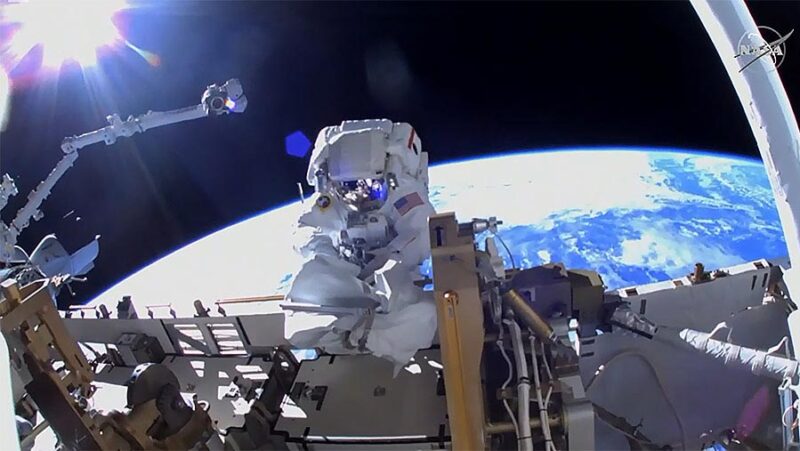
L’astronaute de la NASA Kayla Barron prépare la station spatiale à recevoir un troisième ensemble de panneaux solaires à environ 260 miles au-dessus de la Terre. Crédit : NASA TV
;” data-gt-translate-attributes=”[{” attribute=””>NASA astronauts Kayla Barron and Raja Chari concluded their spacewalk at 3:06 p.m. EDT after 6 hours and 54 minutes in preparation for upcoming solar array installation.
Barron and Chari completed their major objectives for today to prepare the space station for upcoming solar array upgrades by assembling and installing modification kits. The duo built a support bracket onto which a future ISS roll out solar array (iROSA) will be mounted. So far, two of six iROSAs have been deployed on station with four additional arrays to be delivered. The arrays will ultimately augment six of the station’s eight power channels, increasing the station’s total available power from 160 kilowatts to up to 215 kilowatts.
It was the 247th spacewalk in support of space station assembly, upgrades and maintenance, and was the first in Chari’s career and the second for Barron. Chari and Barron are in the midst of a planned six-month science mission living and working aboard the microgravity laboratory to advance scientific knowledge and demonstrate new technologies for future human and robotic exploration missions as part of NASA’s Moon and Mars exploration approach, including lunar missions through NASA’s Artemis program.
Astronaut roles for the next spacewalk on March 23 will be confirmed soon. NASA TV coverage for the March 23 spacewalk will begin at 7:30 a.m. for a spacewalk expected to begin around 8:50 am.
For the Wednesday, March 23, spacewalk, designated U.S. EVA 80, two astronauts will install hoses on a Radiator Beam Valve Module that routes ammonia through the station’s heat-rejecting radiators to keep systems at the proper temperature. The crew members also will install a power and data cable on the Columbus module’s Bartolomeo science platform, replace an external camera on the station’s truss, and conduct other upgrades to station hardware.



